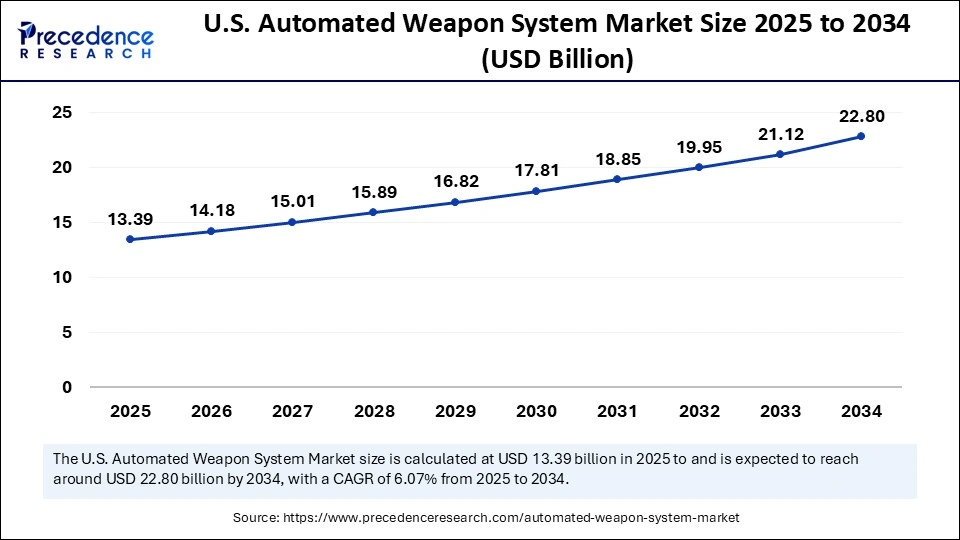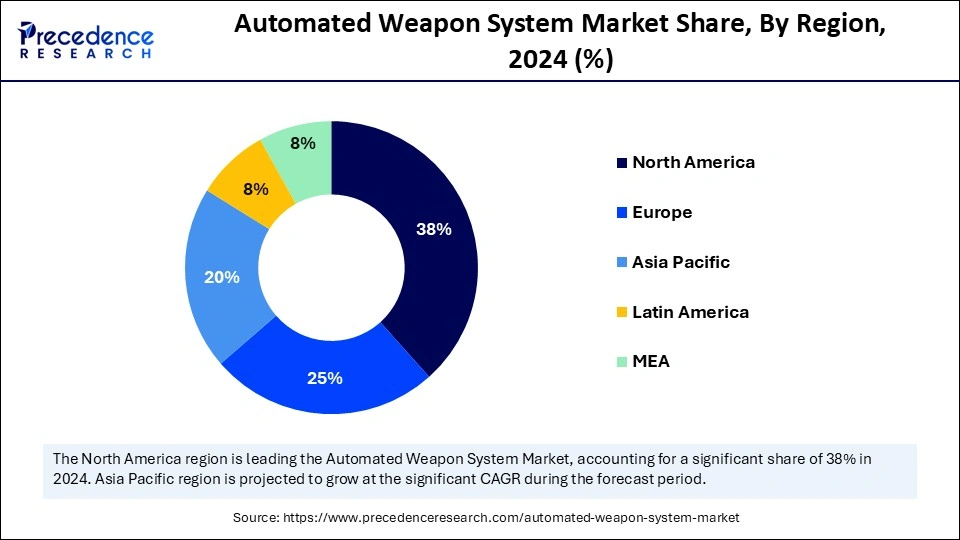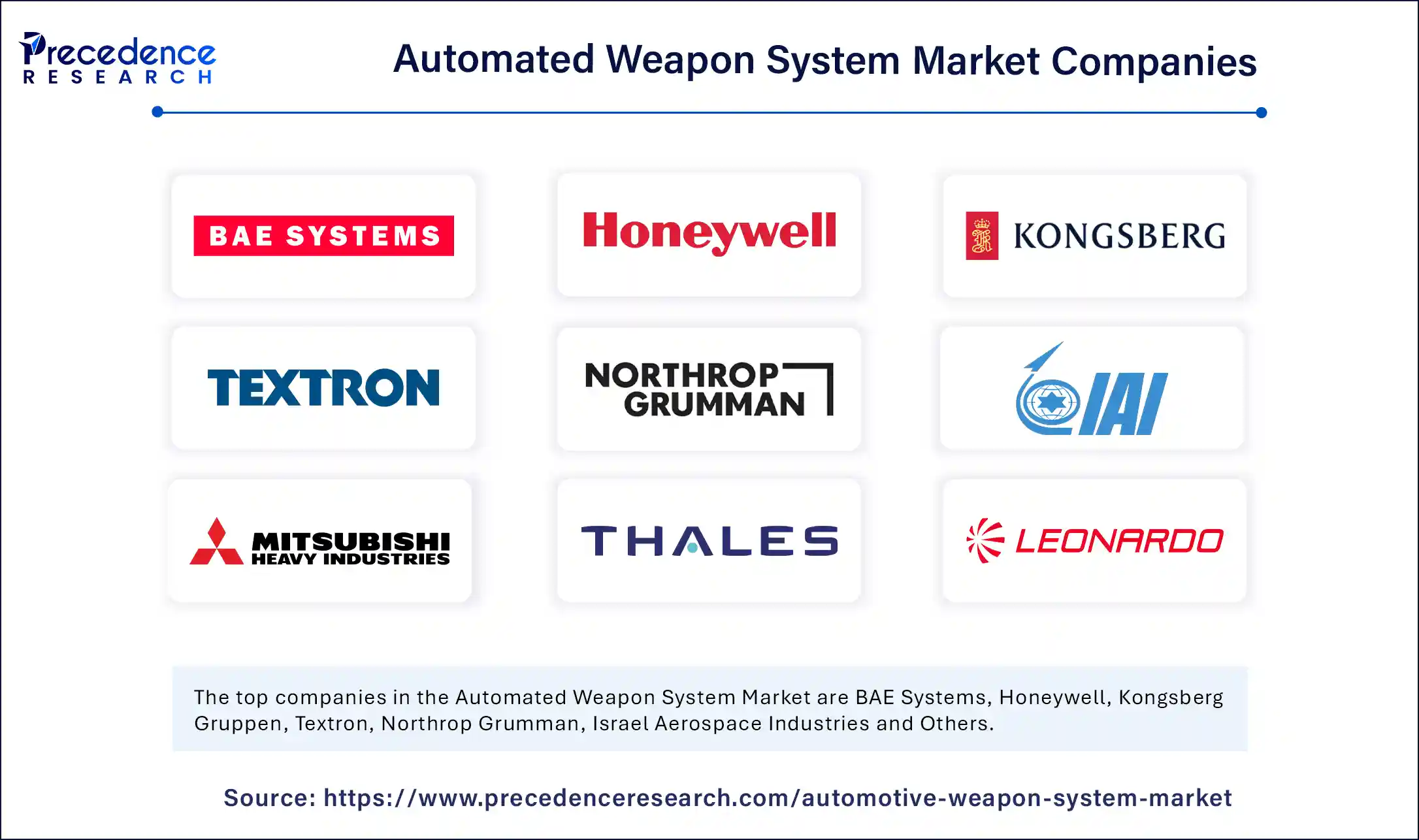List of Contents
Automated Weapon System Market Size and Forecast 2025 to 2034
The global automated weapon system market size accounted for USD 41.62 billion in 2024 and is predicted to increase from USD 44.06 billion in 2025 to approximately USD 73.56 billion by 2034, expanding at a CAGR of 5.86% from 2025 to 2034.The rising military modernization and increasing defense budget drive the growth of the automated weapon system market. Rising regional conflicts are fostering the adoption of automated weapon systems, contributing to market growth.

Automated Weapon System MarketKey Takeaways
- In terms of revenue, the automated weapon system market is valued at $44.06 billion in 2025.
- It is projected to reach $73.56 billion by 2034.
- The market is expected to grow at a CAGR of 5.86% from 2025 to 2034.
- North America dominated the global automated weapon system market with the largest revenue share of 38% in 2024.
- Asia Pacific is expected to grow at the highest CAGR from 2025 to 2034.
- By type, the land systems segment held a major market share in 2024.
- By type, the naval systems segment is expected to grow at the fastest CAGR between 2025 and 2034.
- By component, the sensors segment captured the biggest market share in 2024.
- By component, the command and control systems segment will grow at a significant CAGR between 2025 and 2034.
- By technology, the robotics segment contributed the highest revenue share in 2024.
- By technology, the artificial intelligence segment will expand at a significant CAGR between 2025 and 2034.
- By deployment mode, the on-premises segment generated the major market share in 2024.
- By deployment mode, the cloud-based segment is expected to expand at the highest CAGR between 2025 and 2034.
- By end-user, the military segment held the biggest market revenue in 2024.
- By end-user, the defense contractors segment is expected to grow at the fastest CAGR between 2025 and 2034.
U.S. Automated Weapon System Market Size and Growth 2025 to 2034
The U.S. automated weapon system market size was exhibited at USD 12.65 billion in 2024 and is projected to be worth around USD 22.80 billion by 2034, growing at a CAGR of 6.07% from 2025 to 2034.

What Made North America the Dominant Region in the Market?
North America registered dominance in the market for automated weapon system by capturing the largest revenue share in 2024. This is mainly due to the increased defense spending in the region. Governments around the region have been investing heavily in military modernization. Increased security threats and conflicts are surging the need for advanced and automated weapons and control capabilities. There is a heightened need for counter-unmanned aerial vehicles, driving the adoption of automated weapon systems.
The informal consultations on autonomous weapon systems (AWS), held at the UN in New York on 12 and 13 May 2025, provided an expansive consideration of many legal, humanitarian, security, technological, and ethical dimensions of these weapons. Participants discussed automated weapon systems, which took place at the Group of Governmental Experts (GGE) at the UN Geneva. At least 96 states and many civil society groups participated actively to offer views and raise questions for future examinations.
(Source: https://www.reachingcriticalwill.org)
The U.S. is a major player in the regional market, driving growth due to the country's significant investment in automated weapons and cutting-edge technologies to enhance military & defense capabilities. The U.S. is focusing on the development of AI-enabled automated weapon systems, contributing to market growth. Government initiatives and funding for advanced technologies are fostering the development and deployment of sophisticated automated weapon systems in the U.S. The U.S. is focused on outpacing Russia and Ukraine's AI-enabled automated weapon system development, which is expected to fuel the market. The U.S. military gained $1.8bn worth of funding for AI in the 2024 budget and has more than 800 active AI-related projects in the same year.

Asia Pacific Automated Weapon System Market Trends
Asia Pacific is expected to grow at the fastest rate during the forecast period, driven by rising regional tension and security concerns. Ongoing conflicts between countries like China, India, and Pakistan are driving developments and deployments of sophisticated automated weapon systems. Governments of various Asian countries are investing in modernizing military and defense capabilities. The ongoing integration of advanced technologies with existing defense systems and a strong focus on cybersecurity and unmanned systems are fostering development.
India is a significant player in the regional market due to its strong emphasis on developing AI-enabled and lethal autonomous systems. The India-Pakistan war has strained security concerns. Rising defense spending, technological advancements, and government support are contributing to the increased development of automated weapon systems in the country.
Indian Army Innovations of Automated Weapon Systems
- In June 2025, India announced its successful testing of an AI-enabled light machine gun (LMG) system in high-altitude terrain. Developed by Dehradun-based defense firm BSS Material Ltd., the AI-powered Negev LMG underwent trials in collaboration with the Indian Army at an altitude of 14,000 feet.
(Source:https://www.indiatoday.in)
- In February 2025, at the Aero India 2025 show in Bangalore, the Indian army launched the Ten AI Weapon System (TAIWS) – an artificial intelligence (AI)-based remote weapon designed with night mode and a detection and identification range of 700 m and a 40x optical zoom camera for daytime use.
(Source:https://www.janes.com)
Europe Automated Weapon System Market Trends
Europe is expected to grow at a significant rate over the forecast period due to regions' increased defense spending, growing security concerns, investments in cutting-edge technologies, and increased demand for strong maritime security. NATO members in Europe have increased investment in next-generation weapons technology to improve capabilities. With regions' heavy investments in advanced defense technologies, the development and adoption of automated weapon systems are expected to increase. Countries like Germany, the UK, and France are fostering the development of automated weapon systems due to the presence of key market companies like BAE Systems, Thales Group, Saab AB, and Rheinmetall AG.
Market Overview
The global automated weapon systems market is expanding rapidly, driven by various factors such as increased defense budget, rising modernization of military infrastructure, and preference for advanced technologies. Ongoing collaborations between public and commercial sectors are enabling the production and deployment of cutting-edge technologies, including automated weapon systems. Governments worldwide have increased investments in the military and defense sectors to enhance the efficiency, precision, and reliability of autonomous systems, driven by increased regional conflicts.
Governments are heavily investing in research and development to support the development of innovative automated systems, including weapon systems. The growing geopolitical conflicts between the U.S., Russia, Ukraine, China, India, and Pakistan have boosted the development of automated weapon systems. Additionally, the arms race for AI supremacy and the use of AI in military applications are expanding, contributing to market growth.
U.S. Department of Defense and Its Innovations
In 2024, the Pentagon announced an investment of $1bn by 2025 on its Replicator Initiative for the development of unmanned combat drones that will be designed using AI.
The air force announced a requirement of around $6bn over the next five years to research and develop unmanned collaborative combat aircraft, aiming to build a fleet of 1,000 AI-enabled fighter jets, with the ability to fly autonomously.
The Department of Defense invested hundreds of millions of dollars in its Project Maven, a secret AI initiative. Project Maven is a venture focused on technologies like automated target recognition and surveillance.
- In May 2024, the Pentagon awarded Palantir a $480m contract for its AI technology that helps with identifying hostile targets.
(Source: https://www.theguardian.com)
What are the Major Growth Factors of the Automated Weapon System Market?
- Military Modernization: Governments worldwide have increased funding for military modernization, driving the adoption of cutting-edge technologies in military applications to enhance efficiency and safety standards.
- Security Concerns: Increased security concerns have boosted the demand for automated solutions with efficient, reliable, and great control capabilities, driving the adoption of automated weapon systems.
- Demand for Robotic and Unmanned Systems: The demand for robotics and unmanned systems has increased worldwide, particularly in the military and defense sector, driving demand for automated weapon systems.
- Technological Advancements: technological advancements like the integration of AI, ML, and autonomous systems with military equipment are enhancing precision, surveillance, and decision-making abilities, shifting the defense focus to AI-enabled automated weapon systems.
- Funding for Research and Development: Government funding for research and development of novel and innovative technologies is contributing to the market growth.
Market Scope
| Report Coverage | Details |
| Market Size by 2034 | USD 73.56 Billion |
| Market Size in 2025 | USD 44.06 Billion |
| Market Size in 2024 | USD 41.62 Billion |
| Market Growth Rate from 2025 to 2034 | CAGR of 5.86% |
| Dominating Region | North America |
| Fastest Growing Region | Asia Pacific |
| Base Year | 2024 |
| Forecast Period | 2025 to 2034 |
| Segments Covered | Type, Component, Technology, Deployment Mode, End User and Region |
| Regions Covered | North America, Europe, Asia-Pacific, Latin America, and Middle East & Africa |
Market Dynamics
Drivers
Growing Geopolitical Tension
Growing geopolitical tensions and escalating conflicts are driving significant investments in modernizing military and defense infrastructure worldwide. The adoption of automated weapon systems is increasing due to their better efficiency, reliability, accuracy, and precision has increased. Geopolitical tensions have increased countries' focus on security, leading to increased demand for automated weapon systems. Additionally, access to cutting-edge technologies is enabling the development of an automated system to enhance military equipment efficiency. For instance, geopolitical tension and conflicts between Russia, Ukraine, China, and the U.S. have brought significant development approaches for lethal autonomous weapon systems in 2025.
Restraint
Regulatory Challenges
Regulatory challenges hamper the growth of the automated weapon system market. These challenges include concerns about international law, ethical implications, and accountability. Governments and international organizations have established stringent regulations for legal and ethical development and deployment of automated weapon systems. The development of automated weapon systems challenges the international humanitarian law (IHL) principles. The lack of ethical and moral standards can exacerbate conflicts in international relations.
- In August 2024, the first comprehensive legal framework for AI in the EU, the AI Act came into force. The Act obligates and restricts the application of weapon systems designed solely for military purposes.
(Source: https://www.arws.cz)
Opportunity
Increased Demand from Military and Law Enforcement
The rising demand for enhanced military capabilities, efficiency, and reduced combat risks creates the need for automated weapon systems. Growing security concerns have led law enforcement agencies to adopt automated weapon systems to address threats. The growing modernization of military and defense forces to improve efficiency, precision, and lethality is increasing the adoption of automated weapon systems. The growing defense budget is contributing to the adoption of cutting-edge technologies to advance military capabilities. Additionally, technological advancements are enabling access to more sophisticated automated weapon systems, making them ideal for military and law enforcement applications.
Type Insights
What Made Land Systems the Dominant Segment in the Automated Weapon System Market?
The land systems segment dominated the market with the largest share in 2024 due to the increased land-based border issues. The increased focus on enhancing soldiers' safety in combat has fueled the need for military modernization, driving demand for automated weapon systems such as tanks and unmanned ground vehicles. The automated weapon systems provide improved reaction speed, accuracy, and the ability to operate in environments inaccessible to remote control technologies, making them ideal for land-based operations. The adoption of automated weapon systems like battle tanks, AFVs, and LPVs has increased for ground-based battles combat scenarios.
The naval systems segment is expected to grow at the fastest CAGR during the projection period. The growth of the segment is attributed to the increasing demand for maritime safety solutions. The maritime disputes have increased, driving the adoption of battle tanks, AFVs, and LPVs in combat operations. Moreover, the rising demand for contested sea lanes protection and military modernization initiatives undertaken by various nations support segmental growth.
Component Insights
Which Component Segment Dominated the Market in 2024?
The sensors segment dominated the automated weapon system market with a major revenue share in 2024. This is mainly due to the increased need for advanced tracking, detection, and engagement capabilities on the battlefield. Sensor-based automated weapon systems help enhance soldiers' capability by enabling detection and tracking. Sensors offer real-time data required for decision-making in complex combat scenarios, making them ideal for target acquisition and surveillance. Sensor technology plays a crucial role in autonomous and semi-autonomous robotic platforms.
The command and control systems segment is expected to grow at a significant CAGR over the forecast period. The segment growth is attributed to the rising demand for automated weapon systems for command and control, which are the backbone of military strategy. Automated weapon systems enable real-time situational awareness and enhance decision-making abilities. The modern battlefield environments require high speed and precision, making automated weapon systems integrated with command and control systems ideal for military operations.
Technology Insights
How Does the Robotics Segment Dominated the Automated Weapon System Market in 2024?
The robotics segment dominated the market with a biggest share in 2024, driven by the need to improve the overall capabilities of weapon systems. Robotics play a vital role in improving efficiency and performance of automated weapon systems on the battlefield. Robotics, like combat drones, stationary sentry guns, and autonomous ground vehicles, are increasingly popular for battlefields. The increased asymmetric warfare, border security concerns, and need for advanced military technologies contribute to the adoption of robotic automated weapon systems.
Meanwhile, the artificial intelligence segment will expand at a significant CAGR during the forecast period, due to growing ethical concerns. AI in military & defense, once a hypothetical concept, is now transforming the sector with algorithm-based automated weapon systems. Evolving AI targeting regulations of ‘killer robots.' Ukraine to Gaza have been major countries driving effective approaches in autonomous and artificial intelligence-assisted weapons systems.
Deployment Mode Insights
Why did the On-premises Segment Hold the Largest Revenue Share?
The on-premises segment dominated the automated weapon system market by holding the largest revenue share in 2024. This is mainly due to the increased emphasis on data security and control. On-premises deployments enable the integration of customized technologies with existing legacy systems and provide greater flexibility. Military and defense organizations prefer on-premises deployment of automated weapon systems for greater control over the system, data security, and better operational efficiency.
On the other hand, cloud-based segment is expected to expand at the highest CAGR in the coming years, driven by its flexibility, scalability, and cost-effectiveness. Cloud-based deployments in automated weapon systems enable centralized monitoring, quicker updates, and wider deployment in different locations. The ability of cloud-based deployments to offer advanced remote monitoring, real-time data analysis, and great flexibility and scalability makes them suitable for automated weapons systems.
End-User Insights
Why did the Military Segment Dominate the Automated Weapon System Market?
The military segment dominated the market with a major revenue share in 2024, driven by growing ethical considerations and demand for advanced technologies. Governments worldwide have increased investments in military modernization, enabling the adoption of cutting-edge technologies, including automated weapon systems. Geopolitical tension and cybersecurity concerns are driving the need for automated weapon systems in the military. Automated weapons like homing missiles, radar-guided combat drones, and stationary sentry guns are highly used in military operations.
The defense contractors segment is expected to grow at the fastest rate in the upcoming period. This is mainly due to rising collaborative efforts of defense contractors in the development and deployment of autonomous weapon systems. Defense contractors fuel innovations and technological advancements in automated weapon systems to enhance their effectiveness and capabilities. Ongoing partnerships between defense contractors, government agencies, key companies, and research institutes are facilitating the development and adoption of advanced automated weapon systems.
Automated Weapon System MarketCompanies

- BAE Systems
- Honeywell
- Kongsberg Gruppen
- Textron
- Northrop Grumman
- Israel Aerospace Industries
- Mitsubishi Heavy Industries
- Thales Group
- Leonardo
- L3Harris Technologies
- Lockheed Martin
Recent Developments
- In April 2025, India launched lethal Autonomous Weapon Systems (AWS). This breakthrough comes with the unveiling of an indigenous AI-driven Autonomous Weapon Platform. The platform is designed for small arms and light weapons up to 12.7 mm (.50) caliber and completed its internal trials under the supervision of the Indian Army. (Source: https://www.aviation-defence-universe.com)
- In September 2024, BAE Systems introduced the Autonomous Tactical Light Armor System (ATLAS) Collaborative Combat Variant (CCV), a novel uncrewed ground vehicle, or UGV, weighing approximately 11 tons and measuring 8×8. The vehicle was developed in Australia and pitched as a “combat wingman” with the potential for a high degree of autonomy.
(Source:https://www.twz.com)
Segment Covered in the Report
By Type
- Land Systems
- Naval Systems
- Aerial Systems
- Cyber Systems
By Component
- Sensors
- Weapons
- Command and Control Systems
- Communication Systems
By Technology
- Artificial Intelligence
- Machine Learning
- Robotics
- Autonomous Navigation
By Deployment Mode
- On-Premises
- Cloud-Based
By End User
- Military
- Defense Contractors
- Government Agencies
By Region
- North America
- Europe
- Asia-Pacific
- Latin America
- Middle East & Africa
For inquiries regarding discounts, bulk purchases, or customization requests, please contact us at sales@precedenceresearch.com
Frequently Asked Questions
Ask For Sample
No cookie-cutter, only authentic analysis – take the 1st step to become a Precedence Research client